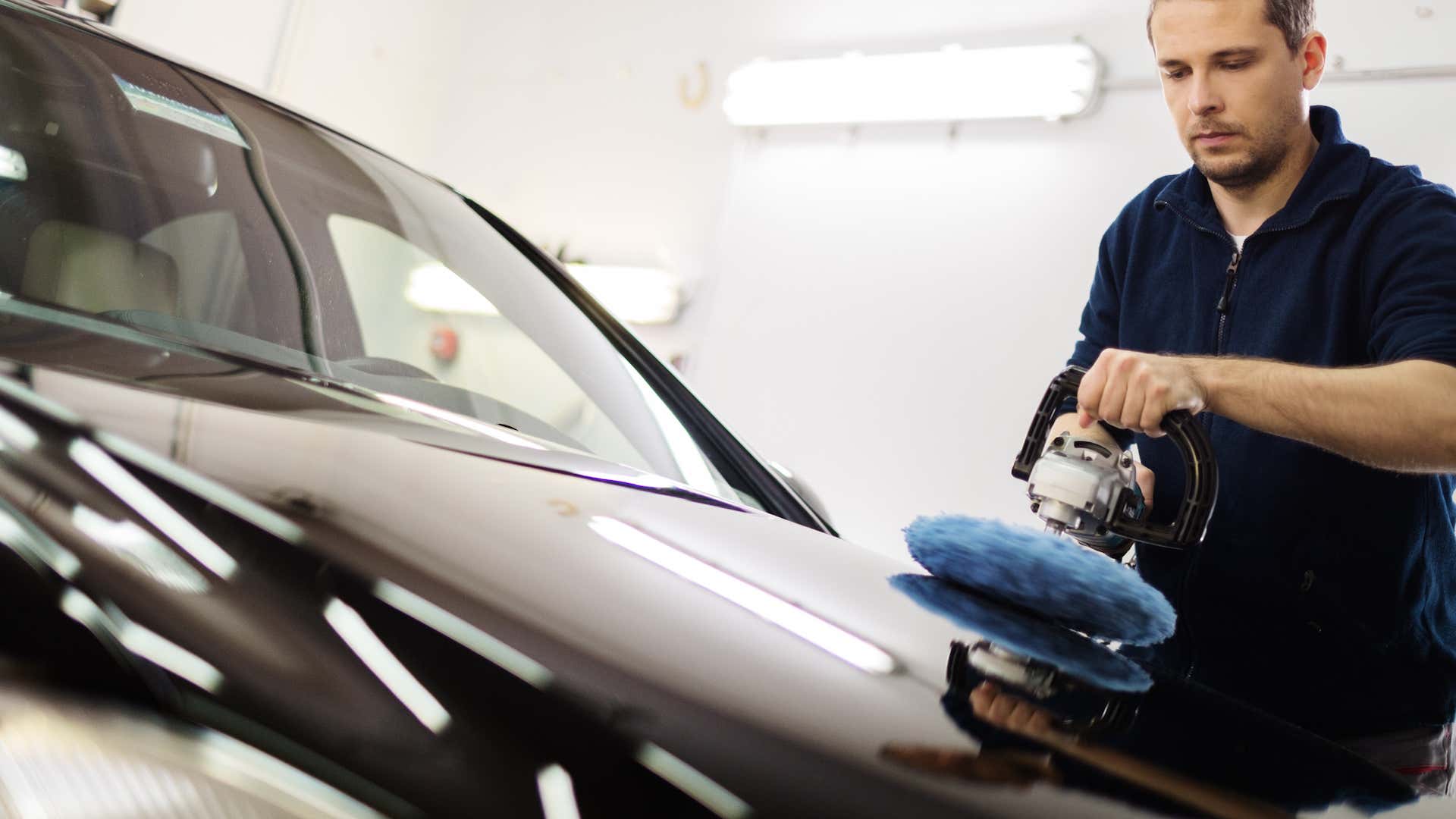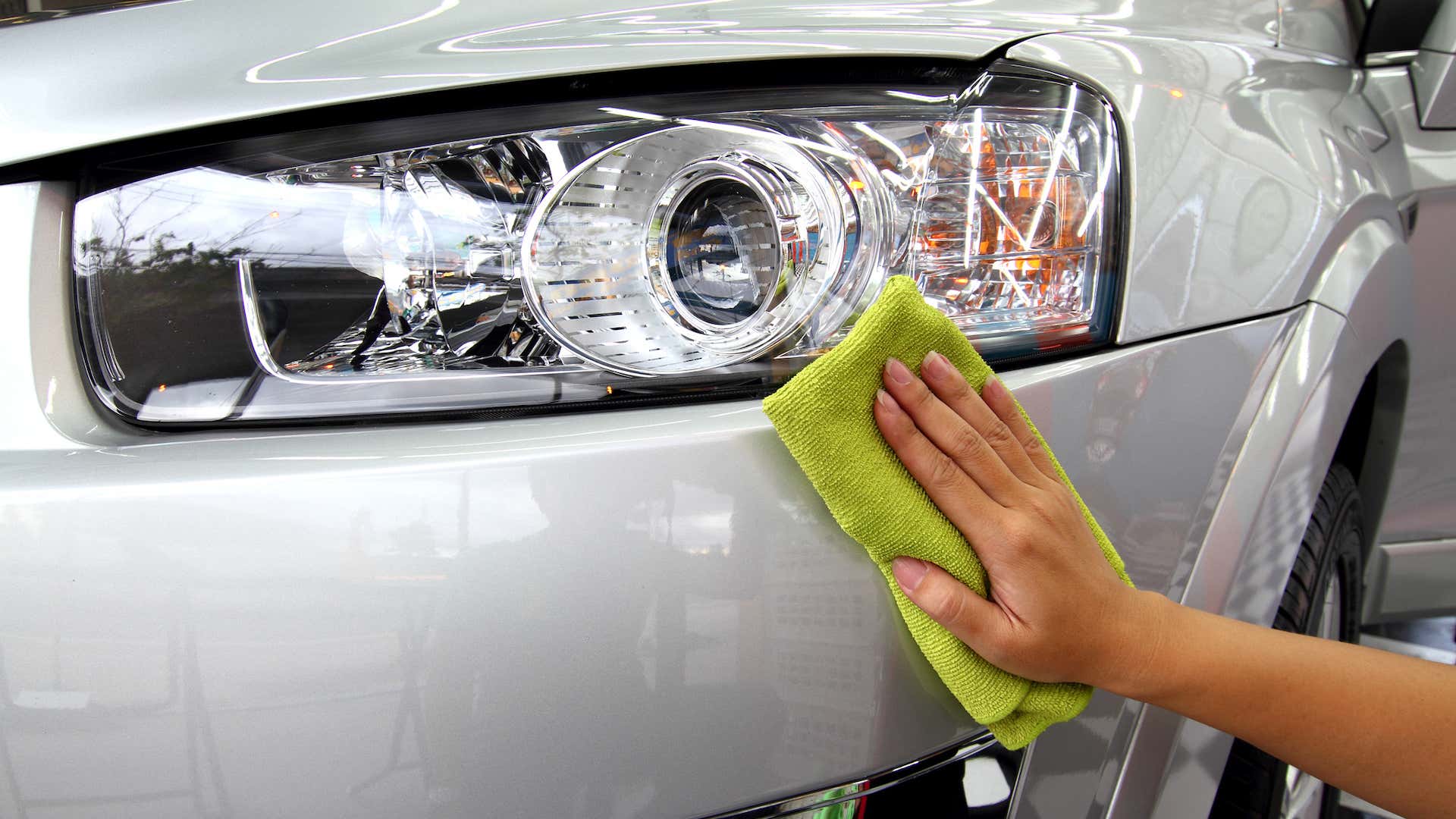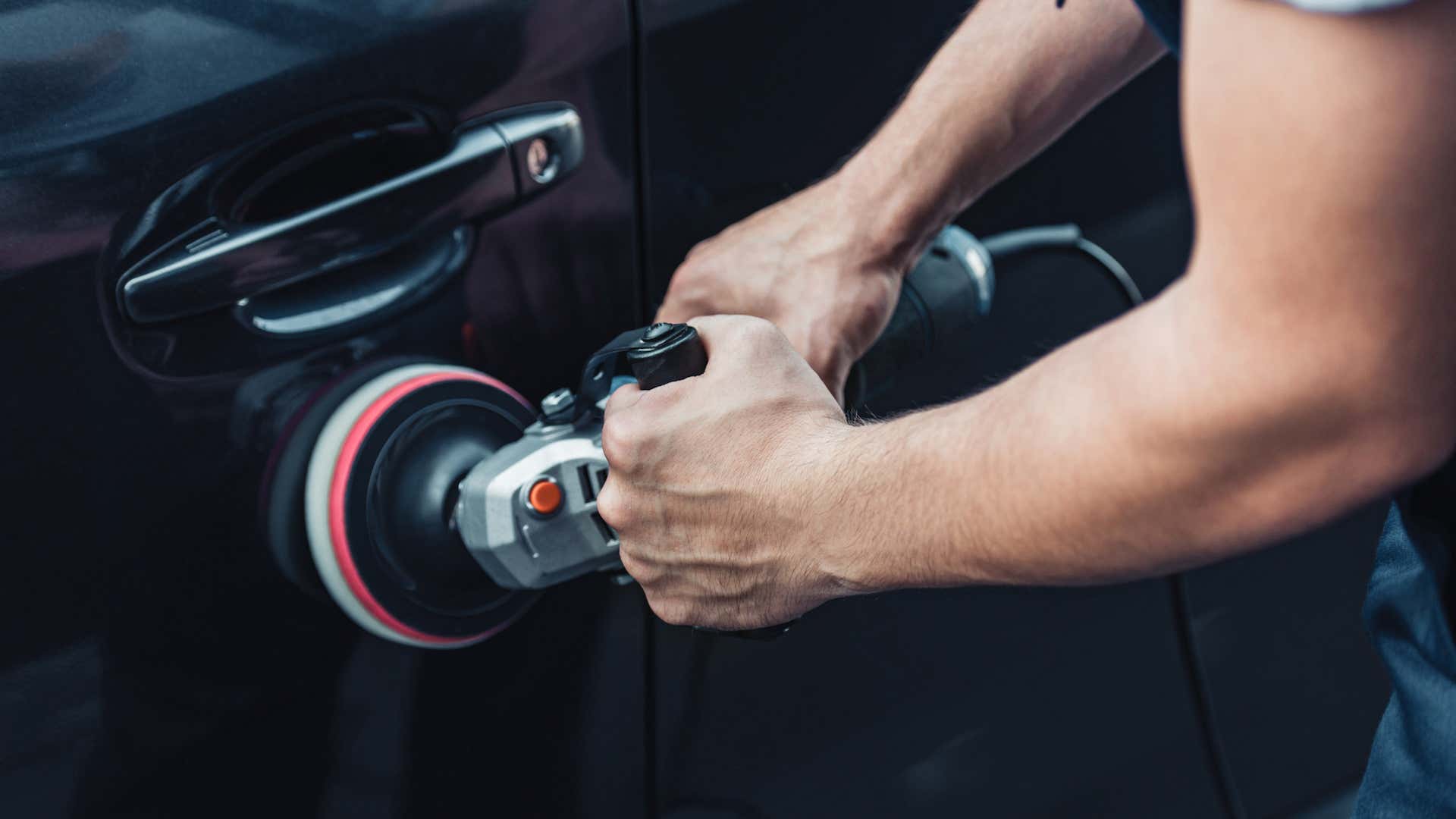Believe it or not, there are people that actually enjoy detailing their cars. People that delight in the process and who enjoy spending the time to polish every surface of their vehicle. It’s tedious, but they love it. And we know those people exist because we’re those people.
That might sound like torture for you, but there are some pretty great reasons to polish your car, such as preserving your paint and being a big ego boost because, afterward, you can cruise around town in a clean car. Oh yeah, you know you see me.
You could pay someone to polish your car, but because the process it pretty straightforward, you can also do it yourself. Either way, it isn’t taxing, as long as you know the basics. So hop aboard with The Drive and let us teach you the ins and outs of polishing a car, and you’ll be riding clean in no time.

Power tools help, but are not required.
Car Polishing Basics
Estimated Time Needed: Approximately one hour, depending on the weather, the size of your vehicle, and how quickly you’re able to polish each section
Skill Level: Beginner
Vehicle System: Exterior
Common Car Polishing Problems
Polishing a car is pretty easy, but you can really mess up the paint if you’re not careful. Here are a few of the pitfalls most commonly associated with car polishing.
- No matter how you’re polishing, you can overwork the polish in an area. The process of polishing is designed to heat up the paint, so it’s important not to spend too much time in one spot or you’ll fry the paint.
- Some people get a little overzealous and try to coat the entire vehicle with polish before spending any time working it into the paint. Don’t be that guy. The only thing that applying too much polish will accomplish is creating a big, dried up mess for you to clean up later.
Car Polishing Safety
While it’s true that polishing a car isn’t quite as dangerous as operating heavy machinery, there are still plenty of things that could go wrong. In general, you should be sure to:
- Avoid getting polish other cleaning solutions on your skin. They can cause rashes or burns.
- If you’re using an electric rotary polisher, it’s essential to keep your hair, jewelry, clothing, pets, and anything else you care about away from the spinning disc. It’s not a saw, but it’ll tangle with loose materials such as hair in a hurry.
- Most car wash and car care products are safe for the environment, but it’s still a good idea not to carelessly dispose of any polishing byproducts.
- Working in a covered space can be great to help protect your new polish job and prevent premature drying, but don’t try working in an enclosed space where fumes can accumulate.

Sometimes, good old elbow grease is best.
Everything You’ll Need To Polish A Car
Fortunately, polishing a car doesn’t take an army of different tools and supplies, but you will need a few things to get started. The most important “tool” is actually having a clean and well-shaded place to work. Working in a sunny or warm environment can cause the polish solution to dry more quickly than you’re able to keep up with polish.
Tools List
- Rotary buffer/polisher or hand polishing pads
- Hose and spray nozzle
- Microfiber cloth
- Car wash brush or pad
Parts List
- Polishing compound
- Car wash soap
- Wax (if desired)
Organizing your tools and gear so everything is easily reachable will save precious minutes waiting for your handy-dandy child or four-legged helper to bring you the sandpaper or blowtorch. (You won't need a blowtorch for this job. Please don’t have your kid hand you a blowtorch—Ed.)
You’ll also need a flat workspace, such as a garage floor, driveway, or street parking that’s well-ventilated. Check your local laws to make sure you’re not violating any codes when using the street because we aren’t getting your ride out of the clink.
Here’s How To Polish A Car
Grab your supplies and park the vehicle in a shaded spot, if at all possible. Polishing isn’t difficult, but you’ll need to give yourself all the time you can to spread the polish and work it into the paint before it dries.
With that out of the way, let’s get into the details!
Polish a Car By Hand
- Remove any nearby objects that don’t need to be polished. Even if you’re working by hand, polishing a vehicle is messy business and you don’t want to make a mess of everything around you.
- Wash your car. Make sure to clean away dirt and debris. Rinse thoroughly with water and dry with a microfiber cloth to remove as much moisture as possible.
- Put a small amount of polish on the applicator pad. Since it’s like a sponge, the pad will absorb quite a bit of polish, but you’ll be able to cut back as you work.
- Working in small sections, spread the polish into the paint in regular, circular motions
- Using a clean microfiber cloth, buff the polish into a shine, area by area.
Polish a Car With a Rotary Polisher
- Move anything that isn’t going to be polished. Using a rotating polisher is extremely messy.
- Wash your car and rinse thoroughly with clean water. Do not dry the car.
- Install a new polishing pad on the rotary tool and apply a decent amount of polish to a small area of your vehicle.
- Using the rotating polisher, spread the polish across the area you’re working with.
- Keep the spinning wheel as close to parallel to the surface as possible.
- Apply constant pressure with the polisher and move evenly across the surface of the car.
- The vehicle’s clear coat will heat up and will become warm to the touch. This is when scratches and other damage will begin disappearing.
- As the polish is absorbed and removed by the polishing pad, the newly shined paint will start to show. As this happens, move to a new area and repeat the process.
- As you move from area to area, you may notice that the polishing pad becomes caked with polish and other detritus. Take care to rinse the pad throughout the process.
- Wash and rinse the vehicle again. Use a microfiber cloth to dry carefully and thoroughly.
You just saved money and time by polishing your own vehicle. Way to go!

Don't work the same spot for too long.
Get Help With Car Polishing From a Mechanic On JustAnswers
The Drive recognizes that while our How-To guides are detailed and easily followed, a rusty bolt, an engine component not in the correct position, or oil leaking everywhere can derail a project. That’s why we’ve partnered with JustAnswers, which connects you to certified mechanics around the globe, to get you through even the toughest jobs.
So if you have a question or are stuck, click here and talk to a mechanic near you.
Pro Tips To Polish A Car
The Drive’s editors have spent our fair share of time polishing cars and fixing botched polish jobs done by people who don’t care to get a job done right. We’ve picked up a few helpful tips over that time that we’d love to share with you here.
- Work in a shaded area. Shade or a covered space will give you more time to work the polish solution before it dries and becomes a mess.
- Move quickly and evenly across the surfaces of the car. Spending too much time in one spot can heat up and damage the paint.
- Keep your polishing pad clean. Gunk and polish residue can build up and scratch your paint.
- Wear old clothing and avoid working near anything that can’t get wet or dirty.
How Much Does It Cost To Polish A Car?
A professional polish can cost anywhere between $50-$200 or more, depending on the type of car you have, the quality of the shop doing the polish, and the level of wash/detail you’ve chosen.
On the other hand, opting to polish yourself can save big cash. You probably have some of the things you’ll need on hand already, such as a hose and a chamois cloth or microfiber towel. You can expect to spend up to $100 or so to do the job yourself, but that money will buy enough supplies to polish a few times.
How Often Do You Need To Polish A Car?
Your car is your baby, apart from your human and fur babies, so we get it, and we understand that you want to keep it looking as pristine as possible. Even so, you should only be polishing your car every three to four months. It’s not good for the paint, it’s a waste of time, and you’ll spend money unnecessarily.
Life Hacks To Polish A Car
The phrase “work smarter, not harder” applies to polishing a car just as it does to anything else. Spend your time wisely and don’t spend money that you don’t have to.
- Only use small amounts of polish. It goes a long way and being frugal will save money and net a better result.
- If your paint is in terrible shape, you may need to have parts of it repaired before polishing, or you could end up with bald spots.
- Work with clean tools. It’s easy to end up rubbing dirt into your vehicle’s paint.
"car" - Google News
September 30, 2020 at 06:11PM
https://ift.tt/33iddMk
How To Polish A Car The Right Way - The Drive
"car" - Google News
https://ift.tt/2SUDZWE
https://ift.tt/3aT1Mvb
Bagikan Berita Ini














0 Response to "How To Polish A Car The Right Way - The Drive"
Post a Comment